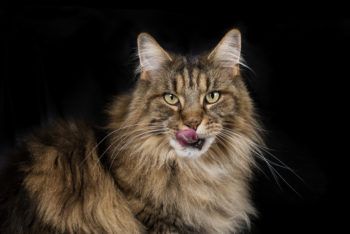Purr-haps A Treat Might Be Nice On National Cat Day Oct. 29

Cat lovers, it’s time to paws and reflect about your furry feline – and to do a little worshiping of them as they would no doubt prefer – in time for National Cat Day on Oct. 29. It’s a day devoted to all things Catdom, and there are a lot of them out there.
Recent statistics show there are about 94 million cats in the U.S. and about 88 million dogs. But before Whiskers starts strutting around knowing fur-real that he is the top dog, more or less, he needs to consider this: he and Fido are far outranked by fish, with an estimated 139 million of them swimming happily around in peopl
e’s tanks, and that has to be a clawful blow to any cat’s ego.
Still, Whiskers does deserve some respect and much-needed attention, said Dr. Audrey Cook, a cat expert at Texas A&M University’s College of Veterinary Medicine & Biomedical Sciences.
For starters, she notes that cats go back many years, and no surprise to cat owners, they sort of did things their way: researchers now believe that cats actually domesticated themselves at their own pace, and were living near farms to catch rodents as long as 12,000 years ago. They gradually cozied up to humans – on their own terms, of course – and became companion animals and eventually pets.
For them, domestication meant life was a whole lot easier – the cat was out of the bag, so to speak.
“When they were in the wild, cats had to spend most of their time hunting for food,” Cook said. “And they would rest when not hunting. Domestic cats don’t need to hunt, so they prefer to sleep, and cats do like to sleep.”
There are many fur-midable facts about cats, such as:
- Cats do like to sleep, and spend as much as 70 percent of their time sleeping.
- Cats have 32 muscles in their ears (humans have only 12). Their ears also help them maintain balance and the ability to right themselves when falling.
- Most cats tend to be more left-pawed than right.
- Cats only meow at people – not at other cats. They do this because they’ve learned they will get what they want.
- Famed scientist Sir Isaac Newton invented the cat door to allow his cat to come and go as it pleased.
- When a cat rubs against your leg, it’s probably not affection. It is marking its territory.
- In Egypt, cats were considered divine, which later prompted the famous T-shirt: “5,000 years ago, cats were worshiped as gods – and they have never forgotten this.”
Any cat owner will tell you they are not easy to train. Being purr-suaded to do something they would rather not do is not in their DNA.
“To train an animal, you have to find a way to effectively motivate it,” Cook said. “For dogs, this may be praise, access to a toy or a food treat. Cats don’t generally respond to these options, so it is very difficult to change or direct their behavior.”
In the cat-egory of famous cat lovers, you will find Winston Churchill, Abraham Lincoln (he always had at least four cats in the White House), writers T.S. Eliot, Charles Dickens, Lewis Carroll, Ernest Hemingway (who owned at least 30), Edgar Allen Poe and Mark Twain (who wrote, “When a man loves cats, I am his friend and comrade, without further introduction”) and celebrities Katy Perry, Taylor Swift, Regis Philbin and even rapper Snoop Dogg.
So why are cats so cat-like?
“Cats are smart, but they just don’t like doing what they don’t want to do,” Cook said. “But that’s their nature – why do something you don’t have to?”
Purr-haps it’s just one more reason for felines to have their quirky cat-titude.
Media contacts:
- Audrey Cook, 979-845-2351, AKCook@cvm.tamu.edu.
- Keith Randall at 979-845-4644, keith-randall@tamu.edu.





